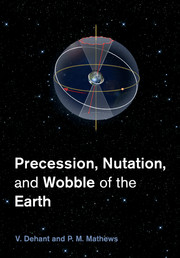Book contents
- Frontmatter
- Contents
- Preface
- List of abbreviations
- 1 Introduction – Fundamental definitions – Motivation
- 2 Concepts and elementary theory
- 3 Reference systems and frames
- 4 Observational techniques – ephemerides
- 5 Rigid Earth precession and nutation
- 6 Deformable Earth – Love numbers
- 7 Nutations of a non-rigid Earth
- 8 Anelasticity
- 9 Ocean and atmospheric corrections
- 10 Refinements of non-rigid nutation
- 11 Comparison observation-theory
- 12 Conventions
- 13 Mars nutations
- Appendix A Rotation representation
- Appendix B Clairaut theory
- Appendix C Definitions of equinoxes
- Bibliography
- Index
8 - Anelasticity
Published online by Cambridge University Press: 05 May 2015
- Frontmatter
- Contents
- Preface
- List of abbreviations
- 1 Introduction – Fundamental definitions – Motivation
- 2 Concepts and elementary theory
- 3 Reference systems and frames
- 4 Observational techniques – ephemerides
- 5 Rigid Earth precession and nutation
- 6 Deformable Earth – Love numbers
- 7 Nutations of a non-rigid Earth
- 8 Anelasticity
- 9 Ocean and atmospheric corrections
- 10 Refinements of non-rigid nutation
- 11 Comparison observation-theory
- 12 Conventions
- 13 Mars nutations
- Appendix A Rotation representation
- Appendix B Clairaut theory
- Appendix C Definitions of equinoxes
- Bibliography
- Index
Summary
When an elastic body is subjected to some force, its deformational response is instantaneous; if the forcing is periodic, the response has the same period and the same phase as the forcing.
In some types of materials, in addition to the instantaneous elastic response, there is a small additional delayed response which keeps changing with time. The behavior of anelastic and viscoelastic materials is of this kind. The response of such materials to periodic forcing has, of course, the same periodicity, but the amplitude of the response is slightly larger than in the absence of anelasticity, and the phase lags behind that of the forcing, with a consequent dissipation of the energy of the oscillations in the material. Both these effects are dependent on the forcing frequency.
In terms of material properties, elastic materials strain instantaneously when a stress is applied and quickly return to their original state once the stress is removed; viscous materials resist shear and also undergo strain when a stress is applied but do not return instantaneously to their original state once the stress is removed; viscoelastic materials have elements of both of these properties and exhibit a time dependent strain in response to stress; anelastic materials represent a subset of viscoelastic materials: they ultimately recover fully after removal of a transient stress.
Some properties of viscoelastic/anelastic materials can be put forward, which summarize the above statements: (1) if the stress is held constant, the strain increases with time (creep); (2) if the strain is held constant, the stress decreases with time (relaxation); if cyclic stress is applied, hysteresis (a phase lag) occurs, leading to a dissipation of mechanical energy. Anelastic dissipation results also in damping of the free oscillations of anelastic bodies.
The Earth's mantle behaves anelastically in responding to forcing over a wide range of frequencies (e.g. seismic frequencies, free oscillation frequencies, tidal frequencies).
- Type
- Chapter
- Information
- Precession, Nutation and Wobble of the Earth , pp. 330 - 337Publisher: Cambridge University PressPrint publication year: 2015



